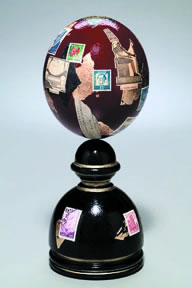There is a poem here somewhere. The Japanese idea of wabi-sabi is central to a romantic ideal of restoration.
My fascination with this subject runs deep because important preservation decisions have consistently been derived from passionate, intense, personal ideas as experts and amateurs defend their understanding of style and material.
Contemporary art often includes an element of decay to intentionally frustrate the whole industry of preservation. Think conceptual art.
Just to set the scene, I imagine 56 shards of a red and black Greek vase lying in pieces on a steel table. Eight pieces of varying sizes are missing. Old Anastylosis goes about gluing the original pieces together with duplicated replacement pieces then painting them to match by assumption of style. The conservator becomes a secondary artist in the process – sometimes centuries after the original artist lays down their brush.
The historical, moral and aesthetic consequences of this unpopular process have been exhaustively debated. But how interesting is a pile of fifty-two shards of an attic crater?
The contemporary compromise includes assembling original fragments and replacing the missing pieces with a neutral ground that can be easily differentiated from the original. All restorations must be reversible and with a material that decays faster than the original. The shape of the vase can reasonably be assumed from the existing pieces.

The exquisitely evocative settlement of Petra is an example of architectural anastylosis that is undergoing extensive revision as funds are raised for yet another restoration. The relentless hot winds of the desert reclaim the sandstone every moment.

Another Example: The Library at Ephesos

A Famous Example of Error in Anastylosis is the Laocoon
Restored Version. Note the Left Arm.
During the highest Renaissance, the fragments of this ancient masterpiece were excavated and they took 'em to the Pope. El Popo sought advice from artists and scholars about restoration. Passionate debates ensued. I like to imagine the characters of the day twisting themselves into the death throes they imagined a Hellenistic murder-by-serpent would require. The Laocoon was one of the most influential finds of the period – perhaps stirring souls toward a more mannerist ideal and then of course to the Baroque. Some contemporary dance group should intrepret Laocoon.
The placement of the arm on a “restoration” would be especially important. Everybody had an opinion. It was a passionate debate. Michelangelo had a good theory that would seem like a man scratching his back but Raphael was the appointed judge and he chose a more active, outward pose - the arm lifting up toward the sky - which was sculpted and joined to the original.
Skip ahead a few centuries to 1957. The original arm was found laying around in a workshop. It was turned inward toward the figure’s back. Michelangelo’s vindication expresses his deeper understanding of classical composition, human emotion, anatomy and the classical sculptural view. An unpopular truth.
Anastylosis continues in preservation communities and conservation labs everywhere, hopefully in a more justifiable and considered way.

One more example, of great, contemporary architectural anastylosis - Eric Lloyd Wright and Joel Silver's restoration of Frank Lloyd Wright's Storer Residence in Hollywood. Don't disturb the residents but if you can see the restoration treatment of the concrete "textile blocks" up close - you'll suddenly understand. This was a diffcult proposition and the treatment is sensitive, evocative and appropriate. Each block was treated individually, respected for its history and repaired carefully with similar but not identical materials. Moss grows through some of the restoration making it one of the most romantic buildings in America. I wish I had a better photo of the exterior. Here's one from Great Buildings Online:


No comments:
Post a Comment